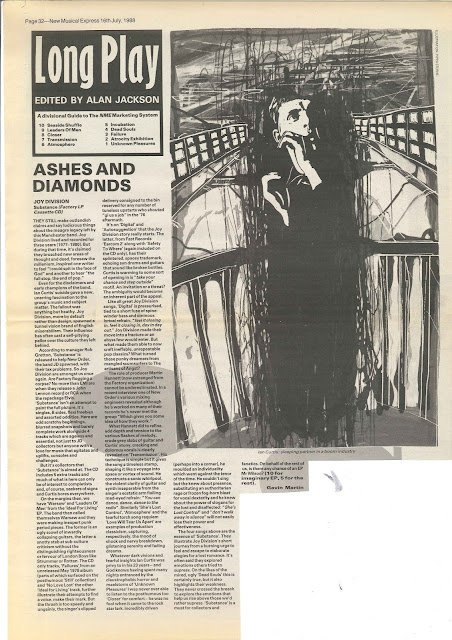Joy Division - NME "Substance" Review 16 July 1988
NME - ASHES AND DIAMONDS
JOY DlVISION
Substance (Factory LP Cassette CD)
THEY STILL make outlandish claims and say ludicrous things about the meagre legacy left by this Manchester band. Joy Division lived and recorded for three years (1977-1980). But during that time, it’s claimed they broached new areas of thought and deed, foresaw the millenium, inspired one writer to feel "I could spit in the face of God" and another to hear "the full stop, the end of pop."
Even for the disclaimers and early champions of the band, Ian Curtis’ suicide gave a new, unerring fascination to the group’s music and subject matter. The fallout was anything but heathy. Joy Division, more by default rather than design, spawned a tunnel vision brand of English miserabilism. Their influence has often cast a self-pitying pallor over the culture they left behind.
According to manager Rob Gretton, ‘Substance’ is released to help New Order, the band JD spawned, with their tax problems. So Joy Division are amongst us once again. Are Factory flogging a corpse? No more than EMI are when they release a John Lennon record or RCA when they repackage Elvis. 'Substance' isn't an attempt to paint the full picture, it's singles, B sides, flexi freebies and assorted oddities. Here are odd scratchy beginnings, blurred snapshots and barely complete work alongside 4 tracks which are ageless and essential, not just to JD collectors but anyone with a love for music that agitates and uplifts, consoles and challenges.
But it's collectors that 'Substance' is aimed at. The CD includes 5 extra tracks and much of what is here can only be of interest to completists and, of course, seekers of signs and Curtis bores everywhere.
On the margins then, we have ’Warsaw’ and ‘Leaders Of Men’ from the ’Ideal For Living’ EP. The band then called themselves Warsaw and they were making inexpert punk period pieces. The former is an ugly scowl of inwardly collapsing guitars, the latter a snotty stab at sub-culture criticism without the distinguishing righteousness or fervour of London Boys like Strummer or Rotten. The CD only tracks, ‘Failures’ from an unreleased May 1978 album (parts of which surfaced on the posthumous 'Still' collection) and ‘No Love Lost’ the other ‘Ideal for Living’ track, further illustrate their attempts to find a voice, make their mark. But the thrash is too speedy and ungainly, the singer’s clipped delivery consigned to the bin reserved for any number of tuneless upstarts who shouted "gi us a job" in the '76 aftermath.
It’s on ’Digital’ and ’Autosuggestion’ that the Joy Division story really starts. The latter, from Fast Records 'Earcom 2' along with ’Safety To Where' (again included on the CD only), has their splintered, spacey trademark, echoing syn drums and guitars that sound like broken bottles. Curtis is warming to some sort of opening in is ”take your chance and step outside” motif. An invitation or a threat? The ambiguity would become an inherent part of the appeal.
Like all great Joy Division songs, ’Digital' is pressurised, tied to a short fuse of spine-winder bass and ominous lyrical refrain: ”feel it closing in, feel it closing in, day in day out." Joy Division made their move into a fracture or an abyss few would enter. But what made them able to now craft ineffable, unrepeatable pop classics? What turned these punky dreamers from mangled scumsurfers to The artisans of Angst?
The role of producer Martin Hannett (now estranged from the Factory organisation) cannot be underestimated. In a recent interview one of New Order's various mixing engineers revealed although he’s worked on many of their records he's never met the group "Which gives you some idea of how they work."
What Hannett did to refine, add depth and tension to the various flashes of melody, crude grey slabs of guitar and Curtis' stony, cracking and dolorous vocals is clearly revealed on 'Transmission'. His technique is simple but it gives the song a timeless stamp, shaping it like a voyage into space or vortex of sound. He constructs a sonic whirlpool, the violent clarity of guitar and synth inseparable from the singer's ecstatic arm flailing mad-eyed refrain: "You can dance, dance, dance to the radio". Similarly, 'She's Lost Control', 'Atmosphere' and the tearful torch song requiem 'Love Will Tear Us Apart' are examples of production, classicism, capturing, respectively, the mood of shock and nervy breakdown, glistening serenity and fading dreams.
Whatever dark visions and fearful insights Ian Curtis was privy to in his 23 years - and God knows having spent many nights entranced by the claustrophobic horror and maelstrom of 'Unknown Pleasures' I was never able to listen to the posthumous too 'Closer' for comfort - he was no fool when it came to the rock star lark. Incredibly driven (perhaps into a corner), he moulded an individuality which went against the tenor of the time. He couldn't sing but the knew about presence, substituting an authoritarian rage or frozen fog-horn bleat for vocal dexterity and he knew about the power of slogans for the lost and disaffected: "She’s Lost Control" and "don’t walk away in silence" will not easily lose their power and effectiveness.
The four songs above are the essence of 'Substance'. They illustrate Joy Division's short journey from a burning urge to feel and escape to elaborate elegies for a lost romance. It’s often said they explored emotions others tried to supress. On the likes of the mired, ugly 'Dead Souls' this is certainly true, but it also highlights their weakness. They never crossed the breach to explore the emotions that help us rise above those we’d rather supress. 'Substance' is a must for collectors and fanatics. On behalf of the rest of us, is there any chance of an EP Mr Wilson?
(10 for imaginary EP, 5 for the rest).
Gavin Martin

Comments
Post a Comment